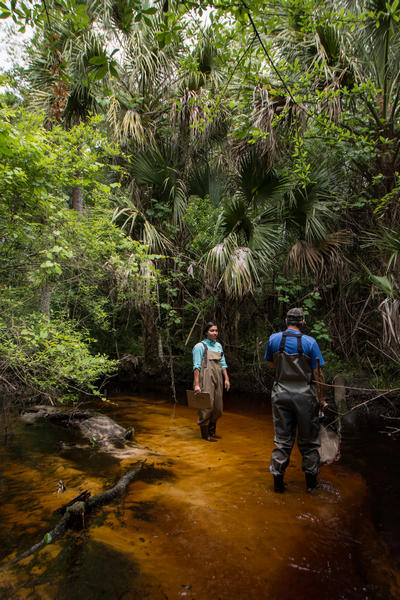DEP Stream Biological Assessment Methods
DEP Lake Biological Assessment Methods
This method is a composite macroinvertebrate index for use in flowing streams.
Training Resources:
Summary of steps required to demonstrate SCI proficiency:
- Attend a DEP biological assessment training class or event. Classes are typically held twice a year: once in North Florida and once in Central Florida. Training classes are announced through the Quality of Science eNewsletter.
- Complete 9 SCI training events with one or more trainers who are in Pass status for the SCI. The Trainer will observe and critique the trainee's sampling technique. Document events on the Training Checklist and Event Log (FD 9000-35).
- An Evaluator will conduct an evaluation (mock audit) for the trainee (10th training event), to ensure the Trainee understands and is proficient in the items on the checklist. Complete the Evaluator section of the Training Checklist and Event Log.
- The audit candidate must attain a score of 90% on the online test and successfully complete a field audit with a DEP auditor.
Proficiency Demonstration:
Anyone submitting data to DEP must attain a score of 90% on the online test, pass an initial demonstration of proficiency (SCI field audit), and a pass a refresher audit every 5 years thereafter.
Contact Ashley O'Neal to schedule an initial or refresher SCI audit, including the online SCI test.
Overall habitat quality is determined by measuring eight attributes known to have potential effects on the stream biota. The method involves a mapping exercise and conducting a series of observations as specified in the Physical/Chemical characterization SOP (DEP SOP FT 3001).
Training Resources:
Proficiency Demonstration:
Anyone submitting data to DEP must pass 3 out of 5 Habitat Assessment proficiency testing sites every two years, ideally within 6 months of when sites were established to assure testing is performed under similar hydrologic conditions. Analysts are expected to test at all 5 sites. Hydrographs are provided for each set of sites to aid in this determination. Analysts must be within +/- 10 points of the overall consensus score for each testing site.
All analysts should test at the sites established in 2024.
2024 Site Information: Northern Sites, Central Sites, Southern Sites
Contact Joy Jackson to submit your Habitat Assessment field sheets and testing scores.
DEP does not currently have any proficiency requirements for the Habitat Assessment Procedure; however, samplers are encouraged to take the online proficiency test linked below to demonstrate their knowledge of the method and provide assurance that data collection follows the SOPs. You may use the HA SOP (FT 3100) to answer the questions. You will have one hour to complete the 40-question test. A passing score is 90%, or 36/40 correctly answered questions.
This method samples macroinvertebrates and is an initial screening tool for streams, intended to rapidly assess a site to prioritize it for more intensive sampling.
Training Resources:
Summary of steps required to demonstrate BioRecon proficiency:
- Attend a DEP biological assessment training class or event. Classes are typically held twice a year: once in North Florida and once in Central Florida. Training classes are announced through the Quality of Science eNewsletter.
- Samplers should undergo field taxonomic training with experienced BioRecon samplers, as well as sampling training as described above for the SCI.
Proficiency Demonstration:
- The audit candidate must attain a score of 90% on the online test, pass an initial demonstration of proficiency (BioRecon field audit), and pass a refresher audit every 5 years thereafter.
Contact Joy Jackson to schedule a BioRecon audit.
This method quantifies the extent and abundance of attached algae (periphyton) in a stream or river and evaluates the ecological information associated with the dominant algae.
Training Resources:
Proficiency Demonstration:
DEP does not currently have any proficiency requirements for collection of the RPS; however, samplers are encouraged to take the online proficiency test linked below to demonstrate their knowledge of the method and provide assurance that data collection follows the SOPs.The RPS online test includes questions about the RPS method, and you may use the RPS SOP (FS 7230) to answer the questions. You will have one hour to complete the 30-question test. A passing score is 90%, or 27/30 correctly answered questions.
Contact Jessica Patronis if you have questions about the RPS online test.
This method was designed to be a rapid screening tool for ecological condition, by determining how closely a site's flora resembles that of an undisturbed condition.
Training Resources:
LVS Calculator:
The LVS is calculated per DEP SOP FS 7320 (effective 4/16/18). An LVS Calculator is available for download and use to calculate Linear Vegetation Survey scores. Users should review "Instructions for use of LVS Calculator" before using (Note: You must enable macros to use this calculator). Please contact Ashley O'Neal if you encounter any errors with the calculator.
Proficiency Demonstration:
DEP does not currently have any proficiency requirements for collection of the LVS; however, samplers are encouraged to take the online proficiency test linked below to demonstrate their knowledge of the method and provide assurance that data collection follows the SOPs. The LVS online test includes questions about the LVS method and plant identification. You may use the LVS SOP (FS 7320) to answer LVS method questions, but do not use any resources for the plant identification questions. You will have one hour to complete the 40-question test. A passing score is 90%, or 36/40 correctly answered questions.
Contact Jessica Patronis if you have questions about the LVS online test.
A rapid field method developed to assess how similar a lake plant community is to a minimally disturbed community.
Training Resources:
LVI Calculator:
LVIs are calculated per DEP SOP LVI 2200 (effective 4/16/18). A new 2024 LVI Calculator is available for download and use to calculate Lake Vegetation Index scores. Users should review the “2024 Instructions for use of 2024 LVI Calculator” before use. The 2024 calculator should be used in place of the previous (2022) calculator. Please contact Ashley O'Neal if you encounter any errors with the new calculator.
Proficiency Demonstration:
Anyone submitting LVI data to DEP must pass the LVI team proficiency testing offered every two years. In addition, at least one member of each LVI sampling team must pass the online test of common lake plants annually. Samplers are encouraged to take the online LVI method test linked below to demonstrate their knowledge of the method and provide assurance that data collection follows the SOPs. You may use the LVI SOP (LVI 1000) to answer the questions. You will have one hour to complete the 32-question test. A passing score is 90%, or 29/32 correctly answered questions.
Contact Ashley O’Neal to take the online plant test.
For information about LVI Team Proficiency Exercise (2023), see Lake Vegetation Index 2023 Team Proficiency Report.
The Lake Vegetation Index 2025 Team Proficiency Report will be available soon.
Additional Resources



